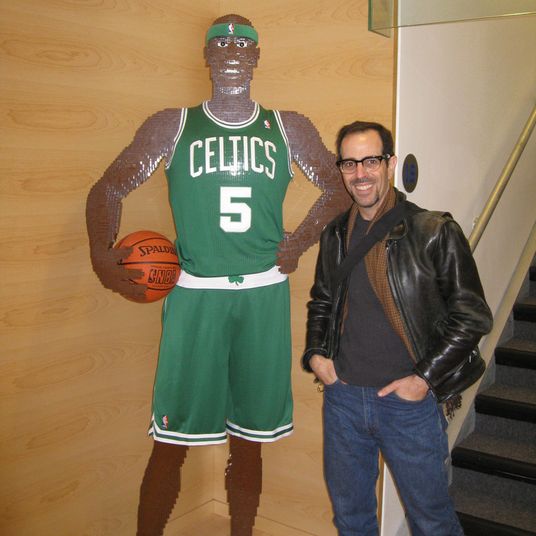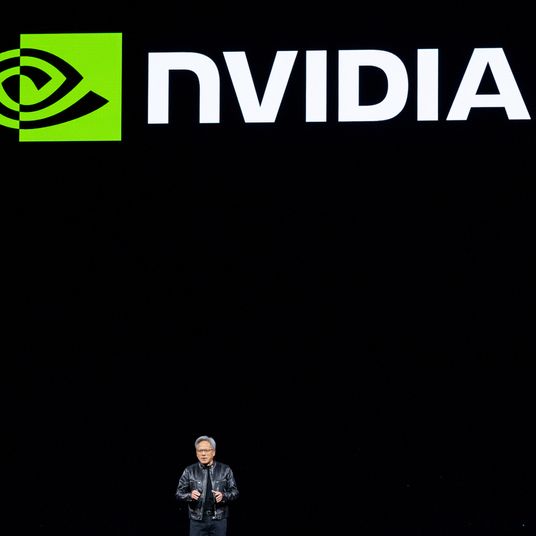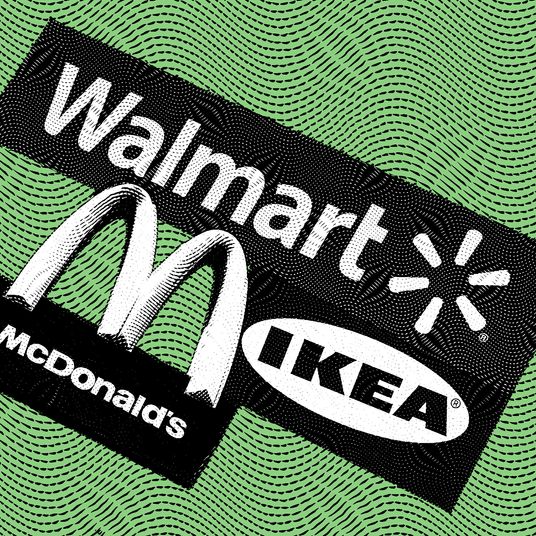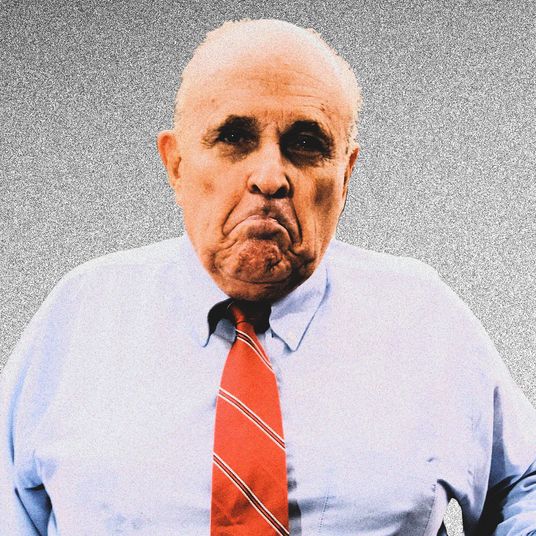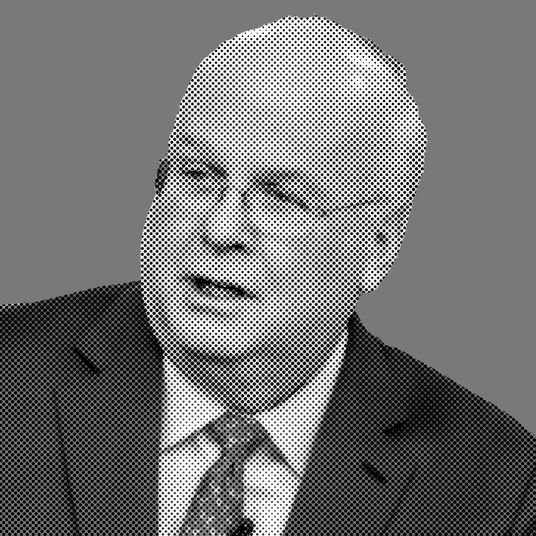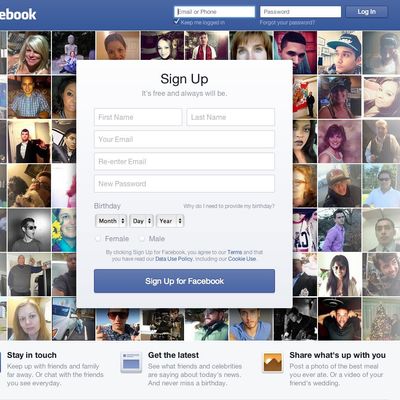
Five or six years ago, when Facebook was still in its adolescence, barely an hour passed in which I didn’t check the site for something new. Facebook was the best way — the only way, really — to share personal news, keep in touch with far-flung friends, and learn about people I’d just met. Every day, I spent hours scrolling through stories, commenting on photos and statuses, and posting my own updates. In the digital town square, I had a permanent bench.
Then, sometime in 2010, my fascination faded. Mark Zuckerberg’s simple creation was getting cluttered with new, intrusive features and ads. My friend list was filling with strangers. And social games and other notification-heavy apps had made a rancid hellscape of my news feed. (The FarmVille Age of 2010-2011 was particularly dark.) Around the same time, I started using Twitter as my primary social network. Twitter had breaking news and smart, interesting people, but its biggest asset was that it provided a fresh start. Going there felt like attending a lively cocktail party at the home of a tasteful minimalist. Going to Facebook felt like being thrust into a hoarder’s garage.
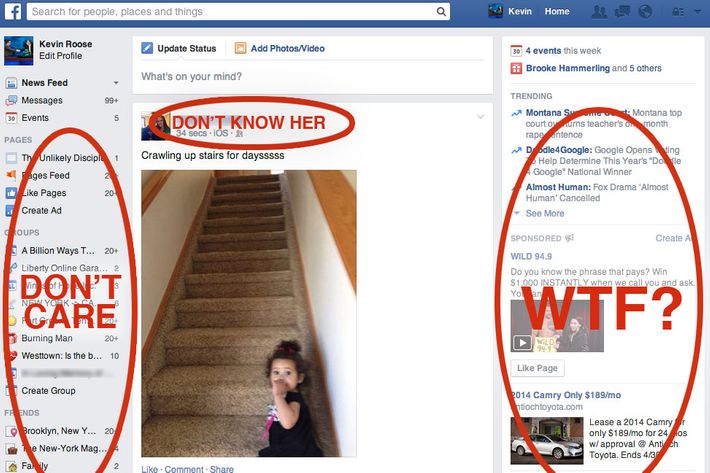
Last week, I decided to give Facebook a second chance. I resolved to do a massive deep-cleaning of my Facebook account — ruthlessly weeding out as much irrelevant, uninteresting, and aesthetically unappealing stuff as possible, no matter how much time it took. By pruning my account to include just the stuff I wanted to see, I would see if New Facebook could be made to feel like the Old Facebook I loved, or if it was beyond repair.
One big reason for my clean-up was professional self-interest. As anyone who creates mass content on the internet will tell you, Facebook is an order of magnitude bigger and more important than any other social network in the world. 802 million Facebookers use the site daily, compared to just over 100 million at Twitter, and the amount of traffic Facebook is capable of driving to stories like mine is almost unfathomably large. Trying to get my stories to a wide audience without the aid of Facebook was like building a house without power tools. (On that note: you can follow me here!)
The second reason was more forward-looking. We’re in the third social media age — the first represented by Friendster and MySpace; the second by Facebook, Twitter, and LinkedIn; and the third, the mobile age, which comprises an assortment of apps with single-function premises (Snapchat, Tinder, WhatsApp, Yik Yak, et al.). Due to its sheer size and the way it’s woven into the web’s basic architecture, Facebook is by far the most likely of the second-wave social media companies to survive into the third wave. And unless I want to rebuild my social media presence every so often as other platforms come and go, I’m better off betting on the heavy favorite.
But first, I needed to clean up my mess.
For help with my Facebook rebirth, I called Will Cathcart, the Facebook product manager in charge of the site’s news feed. “You’re not the first person to have this feedback,” Cathcart said, when I told him about my overcluttered feed. “It’s a thing we’ve tried to tackle in a bunch of different ways over time.”
De-cluttering Facebook feeds, Cathcart explained, is a delicate process with two important steps. First, you have to make sure the user is seeing what she wants to see when she logs in to Facebook. Cathcart and his team have spent years building algorithms that use data about what stories you’re interacting with to determine what kinds of stories you’ll want to see in the future. (Click “like” on a BuzzFeed list, and you’ll probably see more of them; comment on a friend’s photo, and the algorithm pulls that friend nearer.) Facebook also rolled out a “Close Friends” feature that allowed users to create a digital inner circle, and gave those people special notifications and better placement in the news feed.
The second, harder step in de-cluttering is letting users control what’s not on their feeds. Twitter makes it easy to remove spammers and duds — just click “unfollow,” and you won’t see their updates. But for years, it was near-impossible to remove a friend on Facebook — the button was buried in a menu on the profile page, and finding it required serious effort. Partly, this was because Facebook didn’t want users de-friending each other — its entire growth model was based on making connections, not breaking them. But it was also a demand issue. Users rarely wanted to de-friend anyone, even people they disliked, because it could lead to awkwardness later on.
“The feedback we got in testing is that a lot of people are uncomfortable with the un-friending action, because they know that while Facebook won’t tell the other person proactively, it might be possible for the other person to notice,” Cathcart said.
Several years ago, Facebook decided to smooth out the friend-culling process. Users were given a “Hide All From [Name]” button alongside every post on their news feeds, to help them silence other users without needing to officially de-friend them. (The other user wouldn’t see that she’d been hidden.) And, two years ago, Facebook began testing a batch-culling tool — a multi-step wizard that would show users a list of Facebook friends they hadn’t interacted with in a long time, and allow them to move those friends en masse to a friend tier called “Acquaintances,” which would make their posts appear much less frequently on the news feed. This wizard, code-named “Spring Cleaning” inside Facebook, was launched under the name “Organize.”
As it played around with tools for de-cluttering, Facebook has tried to introduce new methods for cleaning house. The company experimented with several names for the button that makes a friend’s posts disappear from view (but doesn’t de-friend them altogether), and eventually settled on “unfollow,” the term Twitter uses. The new name made a huge difference; after Facebook switched from “Hide All” to “Unfollow,” the number of users clicking the button tripled.
“People like the softer approach,” Cathcart explained.
But I didn’t need a soft approach. I needed merciless bushwhacking. Of my 2,789 Facebook friends, maybe 100 are close friends or family members, and 500 are the kinds of people whose posts I’m interested in seeing every day. The rest can go.
Facebook doesn’t have a tool for the kind of deep-cleaning I want. Even the Organize tool only allows me to take a few dozen people off my news feed at a time. (It has a “show more” feature that displayed more than 500 possible cuts, but several of those were my actual friends.) So, one by one, I began clicking “unfollow” when an unwanted post popped up in my news feed. I did this every time I opened the Facebook app on my phone, or went to the site on my laptop — five unfollows here, ten unfollows there. Over the course of several days, I unfollowed nearly a thousand of my Facebook friends, and used the Organize tool to move a few hundred more onto my Acquaintances list. (I probably should have gone further and de-friended these people, but I chickened out.)
Then, it was time to tidy up the rest of my account – including leaving Facebook groups I’d joined in college, unliking pages for friends’ projects I’d been guilted into supporting, cutting off permissions for various apps and games I’d accidentally let onto my digital lawn. I then went through my privacy settings, tweaking and testing each micro-control to make sure each part of my profile would be seen by exactly the right group of people.
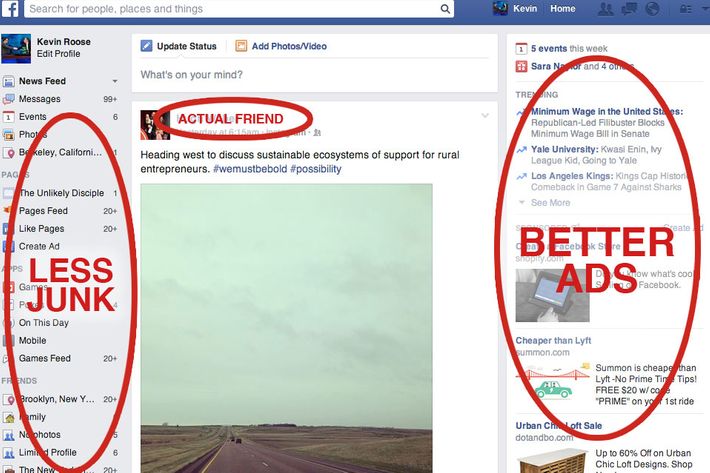
The good news is that I’ve managed to make Facebook feel like a familiar, homey place again. The bad news is that it was a pain in the ass. It took perhaps five hours, start to finish, to power-wash my Facebook account. And it’s still not perfect.
Cathcart and his team have been working hard on tools that will fine-tune the Facebook experience for clutter-haters like me (including a “Make News Feed Better” feature that presents you with different kinds of posts and asks you which you prefer, then factors your answers into your news feed algorithm). But more is needed. Facebook is ten years old now, and millions of users have undoubtedly become annoyed by the amount of detritus that has accumulated on their profiles over the years. In order to keep these people from giving up and going elsewhere, the company needs to make it as easy as possible for them to wipe the slate clean and start over.
Maybe Facebook should roll out a “reset” button that, when pressed, automatically strips a user’s account down to its barest parts and closest connections. (It has the data to do this — it has, after all, logged every click we’ve made since the beginning of Facebook time.) Making it easy for users to disconnect from each other might sound un-Facebooklike, but it could make the site’s appeal much more durable.
After all, if my project proved how annoying it is to clean up a cluttered Facebook profile, it also showed that the benefits are huge. Now, for the first time in years, opening Facebook produces something other than a Pandora’s Box of baby photos, Crossfit check-ins, and Upworthy videos. Mostly, it shows me things I care about, from people I know, with a fairly sleek and intuitive interface. It’s much closer to the Facebook I used to know and love. And all it took was a five-hour scrub.





